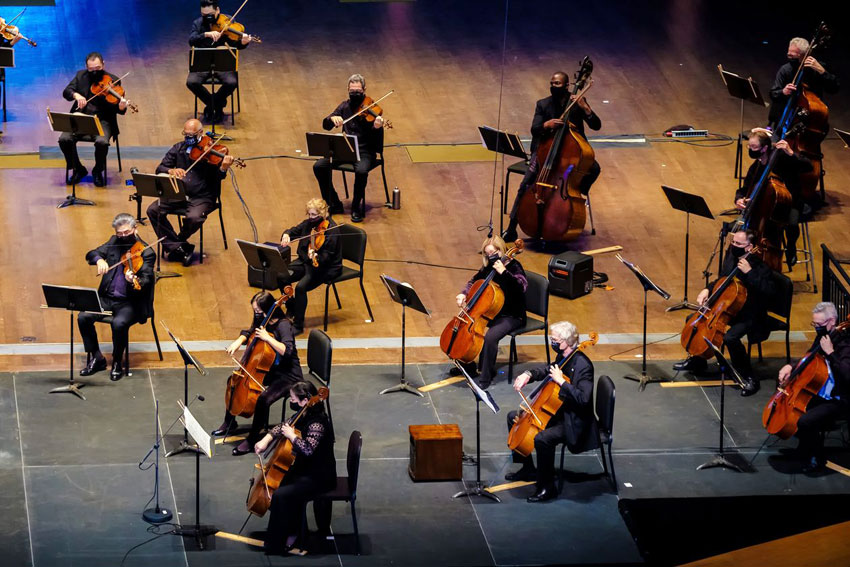American symphony orchestras are emerging from lockdown, adopting a variety of approaches to live performance. Soccer stadiums, ballparks and streets have been pressed into service as safe outdoor venues for socially distanced audiences. Orchestras in states like Florida and Utah are allowing limited audiences inside their auditoriums, but most have opted to make music in their empty concert halls. Some events are filmed before broadcast; others are livestreamed. Players and conductors wear face masks, except for the woodwinds and brass. At the end, they often bow to empty auditoriums.
What follows is a sampling of notable recent concerts. Several ongoing series at last give more attention to African-American composers, and nearly every concert includes a contemporary work—two welcome developments. Compositions for strings are abundant. Shorter-than-usual events of 30 to 60 minutes utilizing up to 40 instrumentalists (versus more typical forces of 70 to 100) are the norm, mainly to reduce health risks. All were technically polished despite the challenges of socially distanced seating or nontraditional settings. Yet these performances had the feel of earnest, occasionally inspired, experimentation—useful steps on the road back to full live performance.
Stylish production values and top-notch performances characterized the first concert in the free Los Angeles Philharmonic “Sound/Stage” series. Filmed ahead and available on the orchestra’s website for 30 days, it proved a model of how to present classical music to a wider public. Titled “Love in the Time of COVID,” the program was a moving acknowledgment of global loss and longing. As the camera panned over the empty Hollywood Bowl, a narrator read the Spanish text of Peter Lieberson’s “My Love, if I die and you don’t,” the fifth of his exquisite “Neruda Songs” based on love sonnets by Pablo Neruda. Composed while Lieberson’s wife was dying from cancer, they were sung compellingly by mezzo-soprano J’Nai Bridges. Then came George Walker’s elegiac “Lyric for Strings,” which fans of Samuel Barber’s Adagio may want to check out if they don’t already know it. Music director Gustavo Dudamel conducted with tasteful expressivity, concluding with the yearning Adagietto from Mahler’s Fifth Symphony. The next filmed classical concert is on Oct. 23; Mr. Dudamel will lead Beethoven’s Seventh Symphony.
When a “sold-out” audience of about 350 in the 2,900-seat auditorium applauded orchestra members and guest conductor Xian Zhang as they filed onstage for the Houston Symphony Orchestra’s “Live from Jones Hall,” it almost felt like a pre-pandemic concert experience. In the Oct. 3 program, Ms. Zhang led an insightful performance of Anna Clyne’s affecting “Within Her Arms” for string orchestra; a lament in memory of her mother, its winding, swooning lines for strings slowly blossom into a wrenching, rhapsodic utterance. Pianist George Li joined the orchestra for a nuanced performance of Haydn’s Keyboard Concerto No. 11, then burned rubber in his encore of Liszt’s finger-busting arrangement of Schubert’s “Erlkönig.” The next livestreamed concert on Houston’s YouTube Channel, accessible for 24 hours only, is on Oct. 17, with violinist James Ehnes as guest soloist and leader. Tickets are required.
Thursday’s pre-recorded program on the Philadelphia Orchestra’s “Digital Stage,”conducted by music director Yannick Nézet-Séguin, gloriously provided the full orchestral textures I’ve been missing in all-strings programs. The world premiere of Carlos Simon’s deftly orchestrated “Fate Now Conquers,” inspired by the opening to the second movement of Beethoven’s Seventh Symphony, was viscerally exciting. Then the second movement of the Seventh was performed, accompanied by “reactions” to the music by an artificial-intelligence computer loaded with images chosen by digital artist Refik Anadol. The resulting backdrop conjured architectural interiors or resembled multicolored confetti tumbling and swirling. It was fascinating but distracting. Mr. Nézet-Séguin’s lithe, sensitive rendering of Schubert’s Unfinished Symphony was best of all. The next installment is on Oct. 15; when guest pianist Emanuel Ax joins Mr. Nézet-Séguin. Tickets are required and concerts remain available for 72 hours.
“Live From Music Hall” streams free concerts from the Cincinnati Symphony Orchestra’s empty auditorium to home audiences while simultaneously transmitting them to movie-theater-size screens in two civic spaces. (The streams are then available for three weeks.) Music director Louis Langrée, in the Sept. 26 season opener, adroitly led a program of American composers. Soprano Angel Blue was the richly colored, expressive soloist in Barber’s nostalgic “Knoxville: Summer of 1915.” Jessie Montgomery’s “Banner,” for chamber orchestra and guest artists Catalyst Quartet, was a brilliantly conceived take on our national anthem, by turns exuberant, wistful and cynical. The next program, on Oct. 24, features Mr. Langrée and guest violinist Augustin Hadelich.
New York Philharmonic “Bandwagon” concerts follow a different, in-person path. This endearing pop-up chamber series is held outdoors in locations across the five boroughs, aided by countertenor Anthony Roth Costanzo acting as MC and singer extraordinaire from the flatbed of a specially painted truck. I preferred the program for brass in Herald Square (where the aroma of waffles mingled with whiffs of stale urine) to the woodwind selections on a crowded street in Little Italy. The five Philharmonic brass players were superb. Highlights included an arrangement for brass of Lennon-McCartney’s “Yesterday” and Mr. Costanzo’s plaintive solo in “Dido’s Lament” from Purcell’s “Dido and Aeneas.” The final “Bandwagon” weekend is scheduled for Oct. 16-18.
Barbara Jepson | Wall Street Journal
Copyright ©2020 Dow Jones & Company, Inc. All Rights Reserved. 87990cbe856818d5eddac44c7b1cdeb8
Appeared in the October 12, 2020, print edition.
